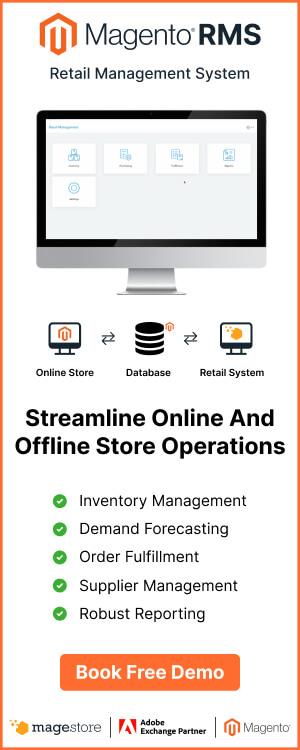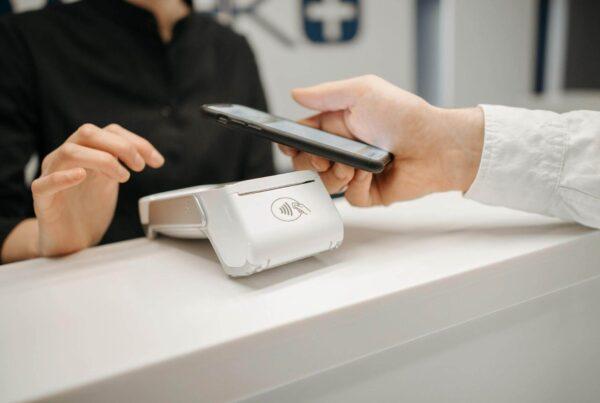eCommerce POS integration is essential as it connects and creates a communication bridge between your 2 main business channels: your online eCommerce platform and offline POS system. This article will dive into the definition, why, and how to integrate POS with eCommerce, and the top POS systems for eCommerce.
- What is an eCommerce POS integration?
- Why do I need an eCommerce POS integration?
- 10 must-have features to look for an integrated eCommerce POS system
- How does a POS system with eCommerce integration work?
- How to integrate POS with an eCommerce platform?
- How much does it cost for an eCommerce integration with POS?
- Top 5 eCommerce POS systems
What is an eCommerce POS integration?
An eCommerce POS integration is a digital solution to build a streamlined connection between your eCommerce platform and POS system. In that way, you can pull detailed data in real time directly between 2 systems and process transactions and orders across online and offline channels.

Why do I need an eCommerce POS integration?
According to a study by Harvard Business Review, customers will spend 13% more in physical stores if they’ve conducted prior online research via the brand’s websites. It means that customers who interact via multiple channels tend to spend more in retail stores.
Thus, it’s critical to provide customers with a seamless buying journey from offline to online to meet their growing expectations. Below are some specific benefits.
1. See inventory in real time and avoid overselling

An eCommerce-integrated POS system allows you to view your inventory in real time across online and offline channels. Streamlining your inventory management across channels is vital to any business owner.
- Track which products may need promotion and which products are hot to order more
- Restock the right item at the right time and in the right place
- Transfer stocks between warehouses and locations
- Avoid out-of-stock and overstock situations to optimize your inventory holding price
You can automate inventory management processes such as:
- Control inventory levels to ensure timely procurement
- Set minimum inventory level according to SKU
- Automated order generation for suppliers with auto-replenishment
2. Eliminate manual data entry

Manual data entry, reconciliation, and synchronization are always error-prone and time-consuming. Therefore, another vast added value of integrating an eCommerce website with an EPOS system is eliminating manual data entry like:
- Synchronizing order information from in-store and online orders
- Manage customer, order, and product information in one place
- No need to update information or reconcile data between channels
This integration reduces your precious time and effort so you can focus on your business.
3. Offer cross-channel promotions and discounts

Manually entering the discount at the POS machine can slow down the customer registration process and increase the risk of fraud. Thus, it’s crucial to have a retail system that seamlessly integrates eCommerce and POS to:
- Streamline loyalty program
- Increase customer shopping experience
- Boost sales and revenue
It provides different strategies to expand your customer base and encourage customers to shop through both channels like:
- Set up and apply discounts across online and offline channels
- Suggest promotions and coupons automatically when checkout on POS and websites
- Accumulate and use loyalty points for online and offline orders
- Purchase and redeem gift cards at both online and offline stores
4. Leverage better customer data and insight

Integrating POS and eCommerce solutions means that you centralize all your customer data in one place.
- Display a consolidated view of shopper behavior across both channels
- Provides more precise insights into your customer preferences and shopping habits
Because customers prefer a consistent experience and interaction across all channels, your retail can improve customer relationships by personalized promotions and offer:
- Tailored marketing proposals based on purchase history
- Run multi-channel promotions (discounts, rewards cards, and other loyalty programs)
5. Enable omnichannel order fulfillment

Customers today prefer an easy and fast shopping experience. Most expect delivery within the same day or even hours. Big retailers like Walmart use their retail stores to fulfill online orders:
- Treat each store as a fulfillment center
- Added a store locator on the website that shows stock availability in each store
- Choose stores that are conveniently located on customer routes
- Forward online orders to fulfillment centers in brick-and-mortar stores automatically
- Continue the process of online orders at the in-store POS system
If you operate a click-and-collect retail business or online purchase — pick up in-store (BOPIS) model, customers will want to determine which store has the item to place an order and pick it up from there. You can implement this model when integrating your eCommerce with POS systems. This:
- Allows your customers to purchase products online and receive them in-store or even by the roadside
- Allows customers to return products purchased online at the store
The customer will have more comfortable delivery options and receive goods faster. Retailers can reduce shipping costs and improve customer satisfaction.
>> Let’s explore top 9 eCommerce fulfillment solutions in 2024 to run omnichannel fulfilling with ease.
6. Improve customer experience

Integrated eCommerce POS solutions solve various business needs in real-time and increase customer satisfaction over their omnichannel touchpoints. It connects your online store to your POS system and creates a seamless customer experience through:
- Different payment methods with POS software
- Seamless online ordering
- Integrated omnichannel marketing and loyalty program
Starting to integrate POS and eCommerce is just the beginning. Think about the bigger picture when smoothly bringing in accounting, shipping, and ERP systems.
At Magestore, we focus on making sure our POS and RMS work with different software and hardware, making your whole business run better. Curious about what’s possible? Check out the seamless integration that Magestore offers:
10 must-have features to look for an integrated eCommerce POS system

There are 10 key features you should consider when looking for an integrated POS eCommerce system:
- Inventory management integration
- Payment integration for online and mobile payments like contactless card processing methods and Apple Pay
- Customer management
- BOPIS or curbside delivery
- Returns and exchanges
- Promotion and discount
- Loyalty programs (reward points, store credit, and gift cards)
- Email marketing integration
- Omnichannel fulfillment
- eCommerce sales reporting
Explore solution: Most customizable & scalable POS for Magento merchants
How does a POS system with eCommerce integration work?
You know the why — now you need the how. Understanding how POS system works with your online store is essential. In general, it’s the automatic execution of retail processes and data sharing between these two channels, including:
- Catalog syncing between brick-and-mortar and online stores
- Automatic inventory updates for in-person and online sales
- Inventory data transfer across 2 channels
- A centralized solution for online and offline transactions with a variety of payment methods
How to integrate POS with an eCommerce platform
There are many approaches to integrate your POS system with eCommerce websites. To choose the suitable method, you’ll need to evaluate your current state by asking yourself a simple question: Have you already had an eCommerce website or POS solution in place?
Based on your answer, below are the 3 scenarios and how to integrate your POS and eCommerce website:
1. You’ve already had a POS, but not a website

If you have a POS system already, you can integrate it with the most popular eCommerce platforms, which have open API architecture like Magento eCommerce.
- Ask your POS provider what available options they offer for integration with eCommerce websites. In some cases, you need to enable the built-in eCommerce service of your POS solution.
- Decide whether to continue with the current provider or switch to another POS system
After that, integrating eCommerce software with POS usually has a clear roadmap from your chosen supplier. First, however, here are the things to keep in mind and the steps to ensure a successful integration:
- Choose a theme: Some eCommerce platforms allow you to create your theme, while others offer preloaded themes and require customization for changes to match your aesthetic and brand identity.
- Synchronize your payment gateway: Set up or integrate your POS system’s payment solution providers with your online website. And note that online sales processing fees are often higher than in-store card transactions.
- Import customer data and inventory: This process can be quick and accurate if you use a data migration service to transfer loyalty points and inventory from the POS system to your online site.
- Set up shipping: Make sure that your chosen eCommerce platform supports or can integrate with your shipping suppliers and shipping fee.
2. You’ve already had a website but not a POS

If your business starts with an online website and plans to expand to brick-and-mortar stores, the integration from eCommerce to the in-store POS system is also relatively easy.
- Determine which eCommerce platform services you want to integrate with your POS system
- Search for POS software that is compatible with the eCommerce platform you are using. Then, use the above requirements to narrow down the options of POS providers, such as retail POS systems or iPad POS solutions.
The roadmap checklist is similar to scenario 1. However, there are a few other things that you need to evaluate when choosing a POS system.
- Payment processor integration: Make sure your POS is compatible or can integrate your existing payment providers. Switching to a new processor is always an undesirable decision for many businesses and their customers.
- Available integration and add-ons: A sound POS system usually has many advanced features like inventory tracking and advanced reporting.
- Curbside pickup: Customers increasingly love the convenient curbside pickup option, especially during the Covid-19 pandemic for safety and contactless payments. Some POS systems support this option. A plus point to boost your sales.
3. You have neither a POS nor a website

If your business is a startup, you can:
- Research an all-in-one solution that integrates the POS system with the eCommerce platform to ensure a seamless connection between 2 channels.
- Find a POS system with a powerful eCommerce platform like a Magento-native POS and choose a long-term technical solution partner. They’ll give you a lot of expert advice and affordable prices without forcing you to use unnecessary features.
How much does it cost for an eCommerce and POS integration?
The cost of eCommerce POS integration is primarily determined by your choice of solution and service provider (free, subscription, or one-time payment). Whether you select a standalone POS or an eCommerce-integrated POS will dictate the associated fees.
Typically, an eCommerce-integrated POS eliminates the connection fee required to link the POS and eCommerce platform since it comes pre-integrated. Below is a breakdown of these fees:
Costs | Standalone POS | eCommerce-integrated POS |
eCommerce platforms pricing plan | ||
POS system registration fee | ||
Cost to integrate POS with eCommerce platform | ||
Development costs for additional integrations or features | ||
Payment processing fee |
Top 5 eCommerce POS systems
Choosing a supplier is always a time-consuming and challenging decision. Therefore, we recommend the 5 best POS solutions that integrate with its eCommerce platform. These are all leading systems that are helping retailers to perform day-to-day tasks efficiently and achieve their business goals:
1. Magestore POS

- Pricing:
- Magestore Magento POS: custom pricing, one-time payment
- Magestore POS for Shopify:
- Lite: $15/month/1 location
- Standard: $50/month/location
- eCommerce integration:
- Native to Magento
- Integrate with Shopify
- Flexible card processing options
- Magento Mobile App version available for your website (require extra cost)
2. Square POS

- Free plan available
- Integration with WooCommerce, BigCommerce, Magento, and other popular eCommerce platforms
- App store access
3. Vend POS

- Starts at $99/month
- Integration with Shopify, WooCommerce, and BigCommerce platforms
- Compatibility with PC, Mac, and iPad
4. Lightspeed POS

- Starts at $129/month
- Integration with BigCommerce, WooCommerce, Shopify eCommerce platforms
- Multiple processing options
5. Shopify POS

- $9/month and $79/month
- In-house Shopify eCommerce
- Integration with Instagram, Facebook, and Amazon
Want a side-by-side of the most popular POS systems for Magento?
Conclusion
Integrating the POS system platform with eCommerce brings great benefits from automating processes and synchronizing data between 2 channels. It saves manual labor, provides in-depth reports and analysis for you to make data-driven decisions, and enhances the customer experience, thereby increasing your revenue.
However, take your needs into account before choosing the integration method. In addition, you can reduce total integration costs by choosing systems that integrate natively between POS and eCommerce. As a result, they’ll be guaranteed options with seamless integration and a reliable system in the long run.
If you’re looking to connect your Magento website with your offline stores, Magestore POS can help you sync data between your channels in real time. You can book a free consultation with us, and together we’ll build a solution that works for your business.
FAQs
1. Why should we use POS software?
POS software works as a bridge to connect your online and offline sales. Besides the ability to integrate with your eCommerce platform, it can link to your inventory management, purchasing management, accounting, customer service, etc. With an advanced POS system, you can enjoy correct and real-time data sync which helps you make informed decisions quickly and easily.
2. What are the 5 types of POS systems?
They are on-premise POS, cloud-based POS, web-based POS, mobile POS, and omnichannel POS. Learning about different types of POS helps you consider and choose the best POS type for your business.
3. What factors to consider when choosing a POS system for my business?
Ask yourself these questions before choosing the best-fit POS system for your business:
- Which must-have features do you need?
- Can the POS system be customized to add more features when you grow?
- How does the provider charge their POS solution?
- How do you pay for the POS solution?
4. What factors to consider when choosing an eCommerce platform for my brick-and-mortar business?
Review 7 following factors before choosing an eCommerce platform:
- Pricing vs. your budget
- Payment processing
- Analytics
- SEO-friendly
- Mobile-friendly
- Integrations and apps
- Support
Explore these factors in detail: Key things to consider with an eCommerce platform
5. Can I transfer data from my old POS system to a new POS?
Yes, definitely. You can transfer your data from the old POS to the new one. One critical decision is to define which information to migrate to your new POS.
The most important POS data includes inventory, orders, customers, and purchasing.
6. What is eCommerce vs POS transaction?
eCommerce transactions are transactions of buying and selling products or services online via computers, mobiles, or other telecommunication devices and equipment.
POS transactions take place when customers make payments at a cash counter or online store in exchange for products or services.
7. What is POS integration API?
This is an API to integrate your point of sale with an eCommerce platform, marketplace, or other business software like ERP.
8. Can POS be integrated with ERP?
Yes, you can integrate your POS with ERP. A POS and ERP integration ensures all your business data is accurate and up to date. It helps reduce human error from manual data entry across your company and also eliminates delays in those updates.














